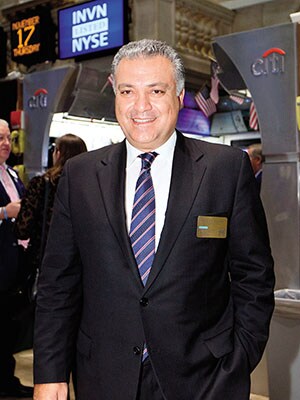
Microchips Maker InvenSense Wants a Slice of Apple
A year after a management shakeup this microsensor company is chugging ahead. Now, if it could only get some of Apple’s business
Ten-year-old InvenSense rarely causes a ripple on anyone’s radar. But on September 20, as Apple’s iPhone 5s hit retail shelves, industry players speculated that the components maker had hit pay dirt, muscling out larger rival STMicroelectronics. Weeks before the release, anticipating that long-awaited debut, investors bid up the stock 15 percent.
InvenSense plays in the $9 billion niche of the semiconductor market called microelectromechanical systems (MEMS), sensors with moving parts so small they can be seen only through a microscope. The components tell your smartphone or tablet if it’s being tilted, twisted, shaken, turned left or right and how fast; compass sensors indicate which way is north and help power onboard GPS.
As tech bloggers ripped open the latest iPhone to anatomise its guts, a ritual known as a “teardown”, you could sense deflation. Inside: An STMicro gyroscope, a compass made by Asahi Kasei Microdevices and a Bosch Sensortec accelerometer.
InvenSense shares opened 3 percent lower. No matter. The stock more than recovered within a week—it’s up 60 percent this year—as investors recovered their senses. The company has shipped 120 million or so units this year to Samsung, Motorola, BlackBerry, HTC, Acer, LG and the Nintendo Wii—70 percent of multi-motion-sensor Android phones and 80 percent of sensing tablets. Over the most recent 12 months it netted $54 million on revenue of $208 million.
Another tumultuous, if little noticed, week in the life of InvenSense. Hardly anyone seemed to register the seismic change last October, either, when the board ousted founder and CEO Steve Nasiri and replaced him with tech veteran Behrooz Abdi. It was a classic entrepreneurial putsch: Get rid of the visionary, do-it-all-yourself guy and bring on the management expert who can scale the company.
“Some board members wanted to influence day-to-day direction of the company,” says Nasiri, 58, who now consults to startups. “I disagreed.” Abdi, 51, who did time at NetLogic Microsystems, RMI Corp and Qualcomm, sees it differently. “As we get bigger, it really gets more complex,” he says. “People felt it needed a new phase of leadership.” Abdi consults with nine vice presidents before making most decisions.

For a long time InvenSense was Nasiri. The Iranian-born engineer started it with $500,000 of his own in 2003, developing an ingenious MEMS fabrication process that bonded all chip components into one package, simplifying manufacture and improving quality. Rivals were making bulky, high-cost products, mainly for carmakers. “I looked at that and said, ‘Ah, I can do that better and keep it under $5,’ ” Nasiri recalls. He also bet early on the consumer end, persuading Artiman Ventures and Partech International to kick in $8 million. In 2006 Nasiri started shipping gyroscopic image-stabilisation components to Sanyo, Minolta and Fujitsu for their digital cameras. Two years later its gyroscope sensors were embraced by the Nintendo Wii game console, adding $50 million to the top line.
“Some board members wanted to infuence the
direction of the company; I disagreed”: Ousted
InvenSense founder Steve Nasiri
Nasiri also had his eye on mobile devices. The arrival of the iPhone, which had an accelerometer sensor, opened up a market for MEMS chips, but Nasiri found it hard to strike deals with handsetmakers. “They weren’t willing to take any bets on any new functions unless Apple had embraced it,” he says. That happened in 2010, when the iPhone 4 included an STMicro gyroscope. By then every smartphone producer had to have one, and Nasiri found work among Android devicemakers.
A 2011 IPO, raising $75 million or so, gave a payout to VCs and employees, who then owned 37 percent of the company, and a booster shot to R&D and the sales force. InvenSense then controlled 10 percent of the consumer MEMS market; today it’s nearly 40 percent, according to Abdi. And drawing excellent reviews. “Their device is superior,” says Andrew Uerkwitz, an analyst at Oppenheimer.
What’s next? Expansion. “Steve brought the company from the kitchen table to a billion-dollar valuation,” says Joe Seeger, director of MEMS development and an early hire. Rapidly growing along with worldwide smartphone sales, sensors should account for almost half of the $12 billion in MEMS chips by 2017.
Over the past year InvenSense has doubled capacity. It’s investing heavily in software that sits on a miniprocessor attached to sensors that handle simple computations that otherwise fall to a phone’s or tablet’s main processor. “The sensor should be smart enough to do at least some lower-level activities and save the battery,” says Abdi.
Sensor technology will push into new areas, like air pressure and accelerometer devices that augment GPS and indoor navigation, pedometers that serve as activity monitors, and image stabilisers for cameras in smartphones. “The cloud is getting smarter,” says Abdi. “It’s going to sense where you are, what you’re doing and how you’re doing.” It’s easy to see how sensors could play a role monitoring the elderly, along with other health care applications.
“You will see a very marked difference in the future of the company,” he says. Maybe even in the next teardown of an Apple device.
(This story appears in the 30 November, -0001 issue of Forbes India. To visit our Archives, click here.)





